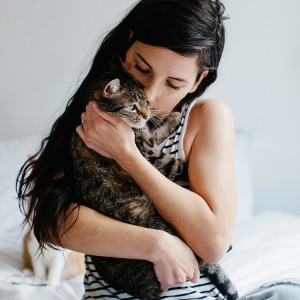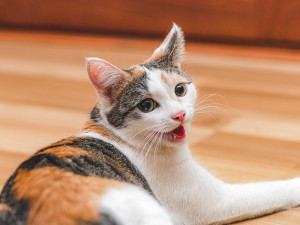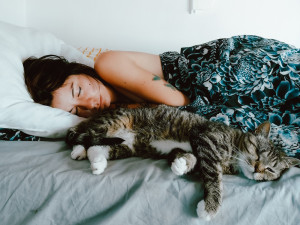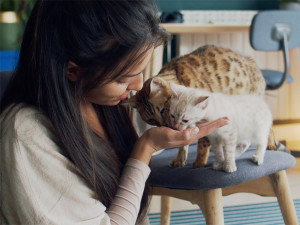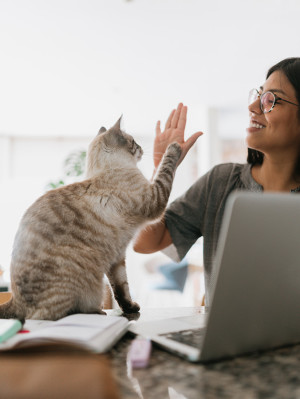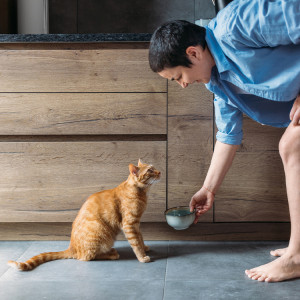What’s Your Cat’s Love Language?
Five surprising ways cats show affection (and how you can show it back), according to a cat behaviourist

Share Article
Cats often get a bad rap because they’re not as demonstrably affectionate as dogs. But just because your cat doesn’t greet you at the door with slippers in their mouth, it doesn’t mean they don’t love you. They just have different – less desperately thirsty – ways of showing it.
How to identify when your cat is showing affection
Some signs of cat affection are obvious: purring, rubbing up against you, allowing you to stroke or hold them. But others can be difficult to decipher, especially if you’re new to cats or have one who seems particularly aloof. Once you know how your cat likes to show affection, you can use that information to show affection back (speak to them in their own language, as it were), strengthening your bond and leading to even more affection down the road.

littleKin™ is Kinship’s home just for puppy and kitten parents. Bop over to check out expert advice, new pet tools, and special deals—all curated for your newest family member.
opens in a new tabHow do cats tell their pet parents “I love you”?
There are a few ways to say “I love you” in cat. Below are some common signs of cat affection.
1. Slow blinking
According to LA-based feline behaviourist and Cat Counseloropens in a new tab Cristin Tamburo, a slow blinkopens in a new tab is a cat’s way of showing you that they trust you and feel safe with you – an essential component in any loving relationship. “Intense staring with wide-open eyes can sometimes be a threatening gesture in cats and stare-downsopens in a new tab among cats often turn into fights,” she says. “But when a cat slow blinks at you, they are showing you that they feel calm and safe in your presence.” So, the next time your cat slow blinks at you, slow blink back and let them know the feeling is mutual.
2. Putting their bottoms in your face
If you have multiple cats, you’ve probably seen them sniffing each other’s bottoms from time to time (just like dogs). But what you might not realise is that the sniff-ee is just as active in this exchange as the sniff-er. It’s just another way for cats to say, “We’re cool”. Now, we’re not suggesting you stick your bum in your cat’s face, but if you want to give it a shot, it probably couldn’t hurt.
3. Showing you their bellies
Don’t get it twisted – this is not always an invitation to touch said belly. Some cats like belly rubs, but many do not and might bite, hissopens in a new tab or scratch. “A cat’s belly is their most vulnerable spot,” says Cristin. “So when they show it to you, they’re saying ‘I trust you’, not necessarily, ‘I want you to touch me’.”
4. Being in the same room as you
Not all cats are snugglers, but just because your cat isn’t big on cuddles, it doesn’t mean they don’t like you. The fact that they don’t leave the room when you enter is proof that they do! If your cat is particularly aloof, try spending time around them. Read a book, mess around on your phone, just let them see that you want to be in the same space as them.
5. Bringing you presents
Cats are hunters by nature and an outdoor cat will often bring their human dead rodentsopens in a new tab (or pieces of dead rodents) as tokens of affection. Indoor cats, on the other hand, might bring toys, pieces of string, or whatever else they find around the house. Accept your cat’s gift in the spirit in which it was intended and give them a little stroke, cuddle or treat to show your appreciation. Or play with them – cats love to play. Sometimes it’s just a matter of figuring out exactly what gets their motors running.
How can I make my cat love me?
The truth is, there’s no way to make an animal love you. Trust is built over long periods of time. If you show them lots of love, they’ll come to love you back – even if all animals show that love in different ways. Give your cat lots of space and time, and never punish your cat.
Just as cats can slow blink to show you love, you can say “I love you” to a cat by slow blinking at them. Dr Karen McComb, a professor who worked on a study on cat slow blinkingopens in a new tab for Scientific Reports, recommends: “Try narrowing your eyes at them as you would in a relaxed smile, followed by closing your eyes for a couple of seconds. You’ll find they respond in the same way themselves and you can start a sort of conversation.”
Are treats and rewards effective as a love language for cats?
If you’re wondering if you can buy your cat’s love with treats and rewards – well, it’s worth a try. Cats love being mentally stimulatedopens in a new tab, so try incorporating treats and rewards into playtime and trainingopens in a new tab for your cat. And keep an eye on the amount of treatsopens in a new tab you feed them (they should never comprise more than 10 percent of your kitty’s diet) because a healthy cat is a happy cat.
Frequently asked questions
How can I show affection using physical touch as a love language?
Stroking a cat can be a great way to bond, but be sure to follow their cue on whether or not they want to be touched. Check out our guide on stroking your catopens in a new tab.
Can a cat have more than one love language?
Like humans, cats can definitely have more than one love language. Plenty of cats show love in a variety of ways.
What if my cat doesn’t seem to respond to any particular love language?
If your cat doesn’t seem to respond to any particular love language, have patience. Cats aren’t always the most expressive and may show their appreciation with subtle cues. If they aren’t resisting your affection by hissing, leaving or taking out their claws, they might be happier than you think.
What does it mean if my cat values a safe environment as their love language?
All cats should have a safe and quiet environment, and providing them with a cosy home is one way you can show your love. Make sure they have a calm space all to themself, especially for eating and using the litter boxopens in a new tab.
How do I know if my cat’s love language is quality time?
If your cat’s love language is quality time, they will spend a lot of time near you or in the same room as you.

Charles Manning
Charles Manning is an actor, writer, and fashion/media consultant living in New York City with his two cats, Pumpkin and Bear. Follow him on Instagram @charlesemanningopens in a new tab.
Related articles
![kitten lying on the floor breathing through his mouth]() opens in a new tab
opens in a new tabIs My Cat... Panting?
“Cats don’t pant to cool off like dogs do.” Unless your pet is catching their breath after doing the zoomies, Dr Gary Weitzman says panting could be cause for concern
![woman with dark hair lying in bed with striped cat, both asleep]() opens in a new tab
opens in a new tabShould Your Cat Sleep With You?
Here are the pros and cons of having a feline sleeping buddy
![kittens licking woman's hand]() opens in a new tab
opens in a new tabCurious Cat Behaviour: Why Does My Cat Lick Me?
Hey, everybody’s got their thing
- opens in a new tab
Dream of High-Fiving Your Cat? Here’s How to Teach a Cat Tricks
It takes some patience (shocker), but it can be done
![dark-haired woman hugging cat that has imprinted on her]() opens in a new tab
opens in a new tab10 Signs Your Cat Has Imprinted On You
Feeling like you have a little shadow these days? A cat behaviourist explains why that’s happening
![Person with short hair putting water bowl on floor for cat]() opens in a new tab
opens in a new tab8 Ways to Get a Cat to Drink Water
Their desert-dwelling roots might resist hydration, but these tricks can help
